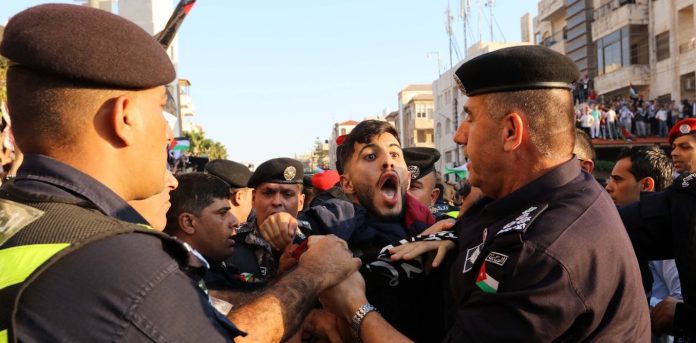Jordan has long been a beacon of stability in the Middle East – but that looks to be changing
Sat in the Wadi Araba in the baking midday sun, senior Jordanian officials and their Israeli counterparts signed a historic peace agreement in 1994 that ended decades of conflict between the two states. Witnessed by the then US president, Bill Clinton, it was just the second peace agreement that Israel had signed with an Arab state, coming over a decade after it made peace with Egypt.
At the same time, artillery fire from southern Lebanon hit targets in the north of Israel in protest, a barrage credited to Hezbollah, the Lebanese Party of God. Now, 30 years later, Hezbollah’s barrage of northern Israel continues amid a devastating conflict in Gaza and escalating tensions between Israel and Iran. Across Jordan, people have taken to the streets demanding that King Abdullah tears up the peace agreement.
Jordan has long been viewed as a pillar of stability in the Middle East. It is a US ally and collaborated with Washington during the war on terror while other Arab states were deeply opposed. But the Hashemite kingdom now finds itself in a precarious position.
Throughout the Arab world, anti-Israeli sentiment has increased dramatically since the bombardment of Gaza that began in October 2023. This anger has been keenly felt in Jordan.
The country provided refuge to many of the Palestinians that were displaced from their ancestral homes in 1948 – the event known as the Nakba. And Jordan is now home to an estimated 3 million Palestinians. This means that events in the West Bank and Gaza reverberate in Jordan.
Pressure is mounting
While demonstrations have taken place across Jordan since the start of the Israeli bombardment, they have escalated in recent weeks. Since March 24, protests have taken place in Jordan’s capital, Amman (including outside the Israeli embassy), as well as in Karak and Irbid.
The protests began as expressions of support for Hamas and opposition to Israel’s actions in Gaza. However, the protesters are beginning to turn their ire to the Hashemite court, the administrative and political link between the king and the Jordanian state.
They have called for an end to the peace deal, halting the export of goods to Israel, and breaking diplomatic relations with Israel. These moves are almost impossible given Jordan’s reliance on aid from the US, a key ally of Israel. But pressure is undoubtedly rising on the Hashemite court.
The protesters have expressed anger at events in Gaza, along with concerns that Jordan would be affected by the forced displacement of Palestinians from the West Bank and Gaza. These concerns are not unfounded, as the events of 1948 demonstrate. Perhaps even more worrying for the Hashemite court are accusations by some protesters that the king is “colluding” with the Israelis.
Fearing what may happen if the protests escalate, the Jordanian government has sought to limit protests. Clashes between demonstrators and security forces near the Israeli embassy and Baqaa refugee camp resulted in arrests, drawing criticism from human rights organisations and increasing the fury of those on the streets.
The pressure on the Jordanian state is also growing from other sources. Funding to the UN relief agency Unrwa was slashed following allegations that its staff were involved in the October 7 attacks. This has affected Jordan directly as Unrwa provides essential services to over 2 million refugees in the kingdom.
Regional instability
Jordan’s geographic position at the heart of the Middle East means that unrest in the Hashemite kingdom poses a significant challenge to neighbouring states, not least Saudi Arabia and Egypt. On April 5, Saudi Arabia’s Crown Prince and de facto ruler, Mohammed bin Salman, called King Abdullah and expressed Saudi Arabia’s “support for the measures taken by the Jordanian government to maintain Jordan’s security and stability”.
Regional news outlets have also come out against the protesters, framing them as Iranian or Islamist stooges. In Al-Arabiya, an opinion piece argued that “Islamist groups want to benefit from [the ongoing protests in Jordan] … and reproduce the Arab Spring revolutions”. The Arab Spring was a wave of pro-democracy protests and uprisings that took place in the Middle East and North Africa in 2010 and 2011, challenging some of the region’s entrenched authoritarian regimes.
In Asharq Al-Awsat, the former editor in Chief, Tariq Al-Homayed, suggested that unrest in Jordan would allow Iran to extend its supply lines to the Mediterranean, giving Iran a “foothold on the Saudi and Egyptian borders”. Another newspaper, Okaz, claimed that unrest in Jordan was part of an “Iranian project to expand Tehran’s influence” across the Middle East.
This fusion of Islamist and Iranian threats may appear counterintuitive given their different political and sectarian characteristics. Islamists such as Hamas and the Muslim Brotherhood adhere to Sunni Islam while Iran sees itself as the leading Shia Muslim power. However, the coming together of the two camps has become more common after the start of the war in Gaza and the shifting contours of regional politics.
A shared anti-Israeli stance is where the two coalesce. Islamist groups, and also individuals, had been used by some as a means of countering Shia and, by extension, Iranian gains after the Arab uprisings of 2011.
But in recent years, Islamist groups such as Hamas and the Muslim Brotherhood have been viewed as a major threat to domestic and regional security by Saudi Arabia, the UAE and others by virtue of their longstanding criticism of rulers in Riyadh and Abu Dhabi.
As the Middle East drifts away from the heady days of normalisation that characterised the spring and summer of 2023, Jordan remains on the precipice. Bringing peace to Gaza is a necessary step in reducing tensions in the Hashemite kingdom, but it alone will probably be insufficient.![]()
Simon Mabon, Professor of International Relations, Lancaster University
This article is republished from The Conversation under a Creative Commons license. Read the original article.



